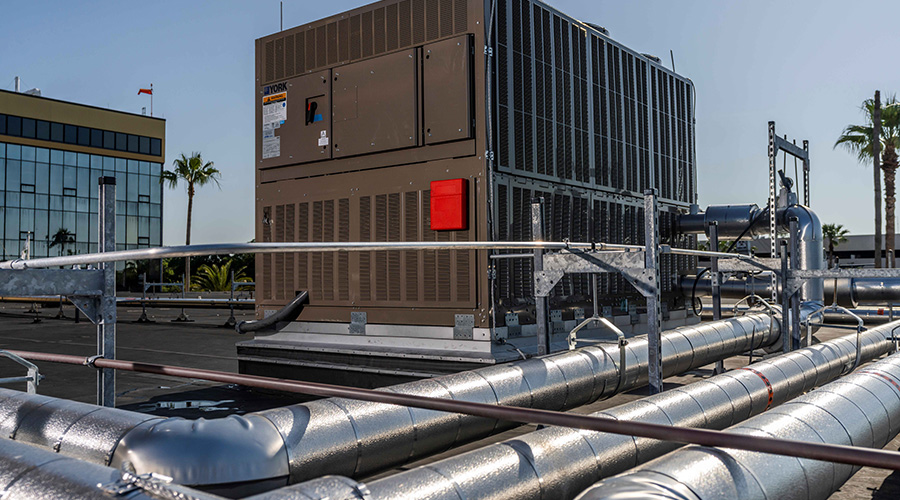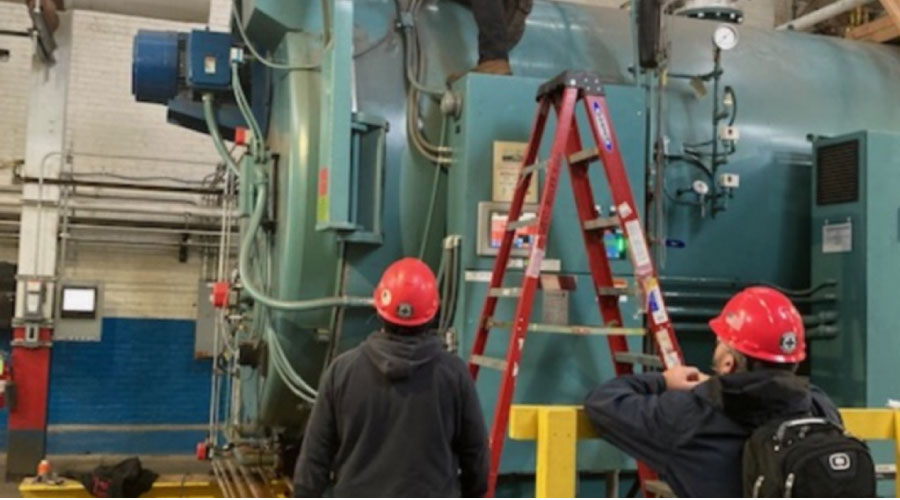Cooling in a Pinch
When facilities need emergency cooling � or even just a little extra cooling � managers need to understand their technology options
Portable, on-demand, HVAC technology has evolved in recent years to help institutional and commercial facilities cope with cooling emergencies and where demand is temporarily greater than system capacity, such as special events. To protect occupants and equipment in such situations, managers need to consider such issues as technology options, cooling needs, and equipment providers.
On-demand Cooling Options
Managers can ensure on-demand cooling using numerous options, from conventional circulating fans and small, portable 12-volt spot coolers to roller-mounted room or area evaporative air coolers and large truck-mounted, 500-ton chillers, which can temporarily substitute for permanent, in-house chillers. Coolers can be more or less permanently situated, as in the case of an extensive repair, or they can be placed for a shorter time or temporary condition.
Aside from conventional portable fans, the three main cooling options are:
- air-cooling, or blowing air over finned tubes, which cools hot fluid to within 5 degrees of ambient
- evaporative cooling, or evaporating water, which works best at 85-100 degrees and where air is fairly dry
- air conditioning, or cooling and dehumidifying by mechanical refrigeration, which works best where the cooling requirement is below 85 degrees.
Evaporative cooling requires air changes to work best because it adds moisture to the air. It works best in dry air — 50 percent relative humidity (RH) or below — and where air is not recirculated but can be ventilated and replaced. Its main advantage is low cost and its suitability for outside or inside use.
Air conditioners that use a refrigerant to remove heat from air are available in many sizes and applications, including those well below the temperature range of evaporative coolers. The capacity of portable air conditioners is 1-5 tons. These units both cool and dehumidify, and they require refrigerant charges of about 30-70 ounces of HFC134a or similar, chlorine-free refrigerant.
The cooling range varies from 12,000 Btu for a 1-ton unit to 60,000 Btu for 5-ton units. Mounted on casters, their small size makes them easily portable. Since they fill a condensate tank in a few hours, technicians should situate them where they can reach a drainpipe to eliminate the need for emptying the tank. At 60 percent RH, they will remove 1-4 gallons of water per hour.
For large applications such as temporarily providing cooling while in-house chillers are overhauled, cooling service companies offer units as large as 500-ton truck-mounted chillers, complete with their own generators. Some examples of where this service can pay off by providing uninterrupted cooling while emergency power is restored or equipment is undergoing repairs include a large telecommunication central switching facility, a school, a hospital, and a central computer server facility.
Gauging Needs
Planning for an emergency means working out all specification requirements — applications, operating conditions, vendor sources, delivery lead time and maintenance — ahead of time so managers can initiate installation quickly in an emergency.
To begin with, managers should consider the coolers’ application. Is this application for people, equipment or an area, or for a combination? What type of emergency is likely to occur — power loss due to storms, power grid failure, in-house distribution system failure, equipment failure?
How critical is the need — hospital emergency room, intensive-care unit, nursing home, schools, commercial offices, computer centers? This answer will dictate specifications for optimum configuration.
Operating conditions encompass everything from temperature and humidity conditions to electric service, which includes volts, phases available, emergency generators available, drains for condenser output, proper supply and exhaust air vents and safety features required.
Managers won’t have the luxury of waiting until an emergency occurs to decide which vendors to contact, so they will have to contact them before an emergency occurs to get bids.
In an emergency, the best possible delivery is immediate. But in reality, response is complicated by such considerations as whether the right equipment available, whether delivery is immediately available, and how long it takes to connect, set up and start. Getting guarantees about delivery time should be a major factor in selecting vendors. Two or three vendor choices increase the odds in favor of getting what you want when you want it.
Next, managers should request vendor bids. Besides spelling out the application and operating conditions, the request for quotes also should include expected delivery time, setup and maintenance services, desired response time for maintenance, and any guarantees that are included.
Working with Contractors
Finally, it is essential that managers consider cooling requirements before a need arises. One possible solution is to prepare a checklist of key information and include it in the disaster-planning procedure. The checklist includes information that will aid the vendor in providing service:
- When does the organization need the equipment and for how long?
- What is the wattage to be cooled and how big is the area to be covered? Equipment such as motors, computers and lighting are big heat sources.
- How hot and does it get? Usually, evaporative coolers work best when the temperature is 95 degree and relative humidity is less than 50 percent. Wetter or cooler ambient air usually requires a waterless cooler or refrigerant air conditioning.
Purchase or Lease?
Maintenance managers who are deciding whether to purchase or lease on-demand cooling equipment need to consider a few key issues.
For example, leasing requires no up-front costs. Instead, customers pay based on equipment use, and they know the cost ahead of time. Vendors include repairs as a part of the lease, so managers can budget for this cost.
Another leasing consideration is guaranteed emergency service. Managers can specify the response time, and while the cost increases as the response time shortens, it might be worth it not to have downtime of mission-critical equipment, such as computers, when the electrical power is disrupted. Managers only pay for the equipment when needed, and weekly or monthly rates are available, depending on needs.
Advantages of purchasing include lower overall cost because the customer only pays the vendor’s overhead and profit once. Departments with experienced HVAC technicians can eliminate maintenance fees, too. For organizations with frequent, intermittent cooling needs, purchasing a portable cooler will ensure ready availability whenever the need arises.
|
Related Topics:











